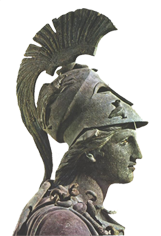PhD theses under preparation
Biostratigraphic and palaeooceanogrpahic study of hot-high atmospheric CO2 events of the Cenozoic at the island of Cyprus (eastern Mediterranean)
PhD candidate:Mary Athanasiou/ Supervisor: Professor Maria Triantaphyllou
Large amounts of release CO2 into the atmosphere have led not only to the increase of percentage reconstituted CO2 and decrease in the level of acidity (pH) of ocean environments, but also to the reduction in degree of saturation of calcium carbonate (CaCO3), in marine ecosystems. Purpose of this thesis is to investigate some of the major warm events of high atmospheric CO2, of Paleocene-Eocene boundary (PETM, 56 Ma), Oligocene (34-23 Ma), Early -Middle Miocene (23-11Ma) and finally the Pliocene warm period (3.29 - 2.97 Ma). The existence of hot periods increased organic carbon content (> 2%) is also associated the sequential deposition of sapropel sediments featuring also the Quaternary period.
Study area of the intervals mentioned above is the island of Cyprus (eastern Mediterranean), and especially the Lefkara formation, Pakhna formation and the formation of Nicosia, overlying the Troodos ophiolite complex of the island. The purpose of this thesis is the high resolution biostratigraphic determination of intervals of interest in the study area based on detailed micropaleontological analyses, and inferences regarding the palaeooceanorgaphy of the selected time intervals and the detection of global paleoclimatic events.
Sedimentary Evolution οf Marine Basins at the eastern end of the Hellenic South Aegean Volcanic Arc
PhD candidate: Vassilis Anagnostopoulos/Supervisor: Professor George Anastasakis
The current Phd thesis focuses on acquisiting, processing and interpreting 2D high-frequency seismic reflection data for theinvestigation of the sedimentary, volcanic and tectonic evolution of marine basins and shelf-margins in the eastern edge of the south Aegean volcanic arc. In addition, multibeamdata acquisition and processing, plus sediment core logging contribute in the stratigraphic correlation of the sub-surface seismic sequences of interest.
Palaeoenvironmental analysis and comparison of the Pliocene sediments of Central Crete and South Peloponnese using marine mollusks
PhD candidate: Christina Giamali/supervisor: Assist. Professor Efterpi Koskeridou
Upper Cenozoic, Sedimentological, Palaeogeographic and Palaeooceanographic evolution of the Saronikos Gulf
PhD candidate: Panagiotis Foutrakis/Supervisor: Professor George Anastasakis
Upper Quaternary sedimentation of Cyclades plateau: a guide to palaeo-bio-geographic evolution of his areas
PhD candidate: G. Kontogonis/Supervisor: Professor George Anastasakis
The purpose of this Thesis is to elucidate the Upper Quaternary sedimentary evolution of the Cyclades plateau through the study of the marine sedimentary seismic stratigraphy and the composition of the sediments. More specifically an extensive marine seismic reflection survey will provide univocal evidence related to palaeogeographic changes that affected the deposition of sedimentary lithofacies. Cores retrieved from different physiographic settings will provide detailed information on the climatic variability of the region during the Upper Quaternary and the possible impact of the arrival of humans on the environment including mammal distribution.
Biostratigraphy and paleoenvironmental analysis in Thrase basin
PhD candidate: Sofia Kostopoulou/suppervisor: Assoc. Professor Maria Triantaphyllou
Study of the Cenozoic Palaeoflora of Aegean
PhD candidate: Dimitra Mantzouka/ Supervisor: Professor Vasileios Karakitsios
The Hellenic area contains plant fossils of great importance for the global scientific community because of: their age, the species and plant organs diversity and the information about the palaeoenvironment and paleoclimate which can be excluded. This work is dealing with: the research for new plant fossiliferous localities of Cenophytic age at the Aegean, the study of the new findings under the perspective of palaeobotany analysis (a great emphasis has been given at the petrified wood – xylotomical – anatomy of angiosperms and gymnosperms with the usage of microscope and studying leaves imprints) and the use of older (method of the Nearest Living Relative) and newer methodologies (study of the Cuticles of the fossil leaves, using methodologies as CLAMP or IPR -Integrated Plant Record vegetation analysis for the Palaeovegetation reconstruction etc.) on newer and older data in order to export significant conclusions about the geological history of the Aegean and of Greece.
Quaternary sedimentary evolution of the marine basins of Kalymnos West Kos
PhD candidate: Emmanouel Markakis/Supervisor: Professor George Anastasakis
Calcareous nannoplankton age and palaeoenvironment determination of Paxoi sequence in Ionian Islands
PhD candidate: Ioulietta Mikellidou/ Supervisor: Assoc. Professor Maria Triantaphyllou
Οntogenesis and functional morphology of Elephas tiliensis with the use of digital methods of representation
PhD candidate: Vassiliki Mitsopoulou/suppervisor: Professor George Theodorou
The current PhD project focus on the biometric and morphometric analysis of the fossilized elephants, Elephas tiliensis of Charkadio cave in Tilos Island, derived from the excavations of 1990 until 2012. The study concerns the representation of many ontogenetic stages of the elephants in relation to morphometric analysis. A set of CT (Computed Tomography) scans will be acquired on the whole skeleton with the aim to define the allometric proportions of the dwarf elephants. The results will be represented by 3D models and CT data and they will be correlated with taphonomical and stratigraphic observations. Finally a corrected anatomical CAD model will be reconstructed. The use of digital representation displays such amazing abilities on defining both the ontogenesis and functional morphology of these elephants. The use of CT files grants the inner look of bones according to their morphology.
Geoarchaeological investigation of building materials and building techniques during the Middle Neolithic in the area of Neo Monastiri, Prefecture of Fthiotis, Greece
PhD candidate: Dimitrios N. Roussos / Supervisor: Professor Vasileios Karakitsios
This research focuses on the archaeological site of Imvrou Pigadi, Prefecture of Fthiotis, Thessaly, Greece that chronologically expands during the Middle Neolithic. Excavations so far have unraveled a very interesting stratigraphy and features that correspond to occupation sequences and floors, walls, ash and midden layers, human constructions (hearths and ovens) and more. More specifically and in conjunction with the methodology, the use of several laboratory methods like XRF, XRD, FT-IR and micromorphology, will reveal the geoarchaeological properties of materials and the archaeological stratigraphy, that will include for instance the properties of building materials and building techniques, the investigation of uses of space, human induced processes like burning and pyrotechnology, post-depositional processes and more. Furthermore, combined with an evaluation of the geology/geomorphology and palaeosols of the area, this research will give specific results on the provenance of materials and will attempt to provide information on the human – environment inter-relations.
Completed PhD theses
Agiadi K., 2013. Palaeontologic and Stratigraphic study of the Plio-Pleistocene sediments of Rhodes and Crete Islands
Michailidis, D., 2013. Taxinomic and Palaeoecologic study of the Pleistocene avifauna of Greece. Ipmlications in the palaeoecology of Homo
Alkowafi, Α.Μ.Μ., 2013. Biostratigrapnic and temporal relations between the Miocene Sahabi and Maradah Formations, Libya. Contribution to the age determination of their contained mammalian palaeofaunas
Kontakiotis G., 2012. Climate changes during the last 150 ka in the Eastern Mediterranean (SE Aegean, Cretan, Libyan Seas): Planktonic foraminifera as paleoceanographic proxies.
Koukousioura O., 2012.Benthic foraminifera as environmental proxies in Aegean coastal ecosystems during the last 10 ka
Kafousia N., 2012. Biostratigraphy, sedimentology, stable isotopes and organic matter of the Jurassic sediments from Western Greece. PhD thesis, University of Athens.
Maroulakis, S., 2010. Quaternary evolution of the Merabello Gulf
Sgouros, G., 2009. Acoustic mapping of selected continental shelf areas of the Merambello and Casablanca gulfs: Seafllor texture determination with digital processing of sidescan backscattering signal.
Tsourou T., 2008. The study of recent ostracod faunas in the coastal environments of Andros Island related to Late Cenozoic assemblages from central Aegean Sea
Lyras G., 2007. Paleoneurological study of the Canidae: Brain evolution and its role in carnivore ecology
Angelopoulos, C., 2006. Sedimentological and hydrodynamic processes in three Greek coastal zones: Drepano (Igoumenitsa), Pahia ammos (Crete) and Kalo Chorio (Crete).
Bakopoulos J., 2006. Lithostratigraphy of the ionian basin in the southern part of Epirus related to the migration and entrapment of its hydrocarbons
Dimiza M., 2006. The study of recent coccolithophore biocommunities in the coastal environments of Andros island and their correlation to the late Quaternary formations from central Aegean Sea.
Stathopoulou E., 2006. The study of the internal micro-morphology and state of fossilization of Cenozoic vertebrates in means of radio-analytical techniques.
Tsaparas Ν., 2005. Contribution to the sedimentary history of the upper Cenozoic marine sediments of Gavdos island

